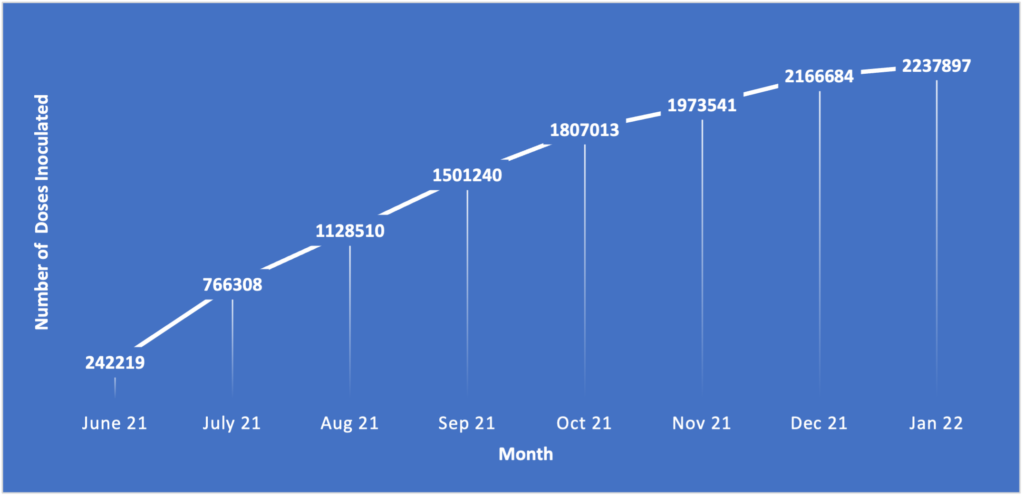
Health systems across the globe experienced significant challenges during the COVID-19 pandemic. In a year, many vaccine candidates received emergency approval; however, from discovery to herd immunity, it poses challenges, primarily in its development, affordability, accessibility, and acceptability. Developed countries faced challenges mostly in its acceptability, while developing countries faced challenges in its rollout, specifically in affordability and accessibility.
In the COVID-19 pandemic management, within the year, multiple vaccines were approved for emergency use globally. It began on December 31, 2020, when the WHO published an Emergency Use Listing (EUL) process for the Pfizer vaccine. In India, the Central Drugs Standard Control Organization (CDSCO), a regulatory agency, permitted using two vaccines, COVISHIELD and COVAXIN, under EUL approvals. It helped the country to organize early vaccination campaigns on January 16, 2021.
As the government of India provided free vaccines to its citizens, affordability did not appear as a challenge; however, accessibility appeared as one of the challenges in India, including Bihar. One of the significant challenges for the health system was to quickly ensure the availability of vaccines to people, particularly for vulnerable populations such as older people, children, women, and individuals with disabilities.
Moreover, initial hurdles encountered during the COVID-19 vaccination drive included the vaccine shortage, hesitancy among the populace, and digital literacy. Moreover, urban areas presented unique challenges due to many factors, such as higher COVID-19 caseload driven by population density, a substantial geriatric population, and the concentration of secondary and tertiary care facilities within urban settings. These factors collectively created an environment that made it challenging to facilitate the movement of diseased people, children, pregnant women, and elderly individuals. These factors created a detrimental impact that led to poor turnout of the vulnerable groups to the vaccination centers. Vaccination Centers carrying testing facilities also inhibited people from visiting vaccination centers.
Vaccine Express
Considering these accessibility challenges, the Government of Bihar decided to take the vaccine to the communities through Vaccine Express in urban areas. On June 3rd, 2O21, Honb. Chief Minister of the Government of Bihar flagged off the “Teeka Express” (Vaccine Express). The Teeka Express is a mobile van shaped like a small utility vehicle. It has four components, i.e., Micro-planning, Community Mobilization, Human Resources and Vaccines and Logistics. The district/city health team collaborated with a representative from urban local bodies and community-based organizations to prepare the micro-plan with all the details of human resources and mobility routes. The vehicle-mounted loudspeaker was used with pre-recorded messages and jingles in Hindi to mobilize the community to the Vaccine Express. The vehicle was easily identifiable because of vaccination branding. Four role-based human resources were engaged, in which two ANMs were playing the vaccinator role, one data entry operator was making registrations (online on Cowin and offline), and he was also maintaining reports and records. The vehicle driver’s role was to take everybody with logistics to the site with the allocated community in Micro-plan for the specific day. Vaccines and logistics were the other components, which included vaccines, syringes, adverse events management kits, and bio-medical waste management, including supplies such as colored buckets, bags, and hub cutters.

In just eight months, from June 2021 to January 2022, 2.2 million doses were inoculated in the urban communities (refer chart below). Anecdotal evidence also suggests that the Vaccine Express was able to cater to the accessibility challenges among vulnerable populations in urban communities. Due to this, the health system ensured the vaccines available during the pandemic.

Learnings and Way Forward
The Vaccine Express improved accessibility among vulnerable populations in urban settings by inoculating vaccines among significant populations against COVID-19. This promising strategy has contributed to understanding the local context and inter-sectoral coordination. Such a strategy could be helpful for the health system in improving accessibility among vulnerable populations and ensuring community health services in urban or underserved settings.
About the authors:
Anand Kumar is a State Program Officer in Urban Health in Jhpiego, India. (Twitter: @optmanand).
Masood Alam is a State Program Manager in the National Urban Health Mission at the State Health Society, the Government of Bihar.
Sanjeev Kumar, MPH*, is a Public Health Professional (Twitter: @snjvkumar386)
*corresponding author
Competing interests: None
Handling Editor: Neha Faruqui